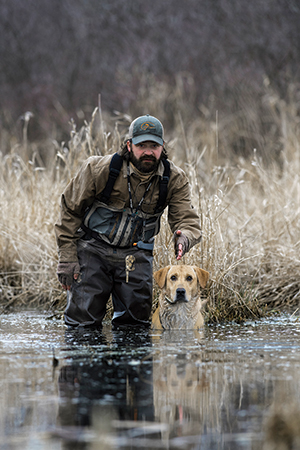
Nov 24, 2019
Canine Corner: Mid-season corrections
Originally published in Winter 2019 issue of California Waterfowl.

by JOSH MILLER/SportDOG® Brand
 With the first part of the season behind us, I am sure we have plenty to look back and smile about. That first big group on opening morning. The long blind retrieve your four-legged partner made on the bird you sailed. The foggy morning sunrises that allowed you to take a deep breath and appreciate where you were.
With the first part of the season behind us, I am sure we have plenty to look back and smile about. That first big group on opening morning. The long blind retrieve your four-legged partner made on the bird you sailed. The foggy morning sunrises that allowed you to take a deep breath and appreciate where you were.
But no matter how many great memories we have, some screws likely came loose with our dog during this first half of the season.
This is to be expected. I don’t care if you have a young dog or a finished Master Hunter, hunting is as uncontrolled as our training setups are controlled. The good news is, you can fix it.
Here’s an example: One of my personal dogs, Sage, is a British lab out of my kennel, and about as intense a female as I have come across. Earlier this season we were in layouts hunting a cut field with Sage in the dog blind behind me to my left. A big group of mallards worked the decoys a couple times, then committed, and we let loose. Birds were falling everywhere. I turned to send Sage, and much to my surprise, she was at my side with a bird in her mouth.
Well, that’s not right.
My buddy must have sensed my confusion, and he explained that a bird he’d shot literally grazed her nose as it fell, and she grabbed it and brought it over to me.
I thought, “OK, well, that is understandable.”
The next group to commit to us was a four-pack, and as the birds started to fall, there goes a little flash of yellow. All I could think is, “This is a dog that is a pass away from her Hunting Retriever Champion title, that has never broken on me, and now this? Where did this come from?”
Well, we all know where it came from: I didn’t take the time right then and there to be sure she wouldn’t break again.
For the next two weeks, Sage did nothing but training – no hunts, as I needed to control as much as possible. She honored other dogs working. I threw pigeon after pigeon in front of her making her watch each one fly. And each bumper I threw for her, she sat and watched me pick it up. Was it fun for her? No. Was it fun for me? No. But we needed to get this right before she found herself in a dangerous situation.
When I felt she was ready to go back in the field, I did not hunt. I needed to make sure the training stuck, and I wasn’t going to find myself in the same place I was just a few short weeks earlier. As each group came in and my buddies cut into them, I stayed focused on my little ball of fire. She was intense, focused and, most importantly, calm and steady. She marked each bird fantastically and was back to her composed, under-control self. I would be lying if I said I wasn’t looking out of the corner of my eye on the hunts that followed, but I was happy to have my little girl back to where she should be.
Of course, this is just one example of what you may be dealing with, but it is important to keep in mind that no matter how good your dog is, these are not robots we are dealing with.
Every situation is different, so there is no single formula for addressing new problems. But here are some things to think about when correcting a mid-season problem:
- You may not be able to replicate the problem. You don’t have birds working the decoys. You are not calling with your focus on the sky. There isn’t the emotional eruption when you call the shot. But you can still work on the problem. Like in my example, Sage NEVER breaks in training, but we still focused on it. That way the next time we went into the field, it was in the forefront of her mind.
- Use the e-collar. Too many people look at this tool as a punishment. It certainly is not. It is a communication tool. When everything is going nuts and your dog’s excitement level rises, the collar will communicate the same message as when you were in the yard training.
- Leave the gun at home. This is the hardest one of all since you wait all year for this moment! But if you bring your gun out and “just won’t shoot,” trust me, you will shoot. Leave the gun at home and make sure you can correct the problem in the environment where it is happening.
There are going to be ups and downs, and there will always be something to work on. This is both the frustration but also the fun of being the dog handler of your hunting group. Take the time to fix new problems now, and you’ll be grateful as the season continues to heat up.
ABOUT THE AUTHOR
Josh Miller is the product training specialist for SportDOG® Brand and owner of River Stone Kennels and Britishlabradors.com. Josh has more than 13 years of training experience and has been successful running in AKC/HRC hunt tests and field trials, and is a five-time NASHDA Championship winner.


